-
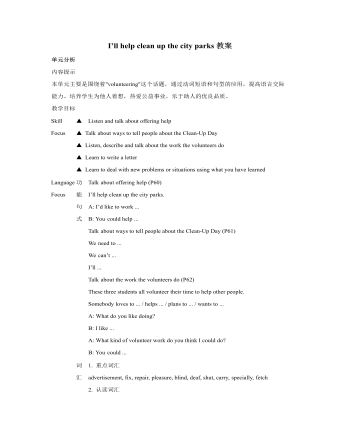
人教版新目标初中英语九年级下册I’ll help clean up the city parks教案
Talk about offering help (P60)I’ll help clean up the city parks.A: I’d like to work ...B: You could help ...Talk about ways to tell people about the Clean-Up Day (P61)We need to ...We can’t ...I’ll ...Talk about the work the volunteers do (P62)These three students all volunteer their time to help other people.Somebody loves to ... / helps ... / plans to ... / wants to ...A: What do you like doing?B: I like ... A: What kind of volunteer work do you think I could do?B: You could ...1. 重点词汇advertisement, fix, repair, pleasure, blind, deaf, shut, carry, specially, fetch2. 认读词汇hunger, homeless, cheer, clean-up, sign, establish, major, commitment, elementary, veterinarian, coach, similar, call-in, strategy, disabled, organization, unable, support, appreciate, donation, part of speech, pronoun, adverb, preposition, conjunction, donate, Jimmy, Sally3. 词组clean up, cheer up, give out, put off, set up, think up, take after, fix up, give away, put up, hand out, work out, at once
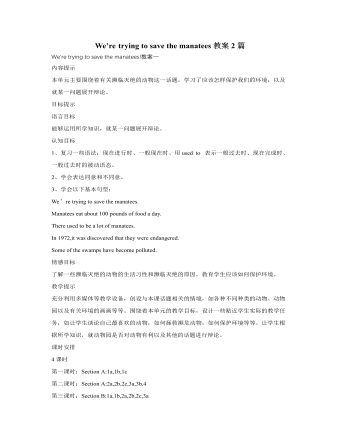
人教版新目标初中英语九年级下册We’re trying to save the manatees教案2篇
本单元主要围绕着有关濒临灭绝的动物这一话题,学习了应该怎样保护我们的环境,以及就某一问题展开辩论。目标提示语言目标能够运用所学知识,就某一问题展开辩论。认知目标1、复习一些语法:现在进行时、一般现在时、用used to 表示一般过去时、现在完成时、一般过去时的被动语态。2、学会表达同意和不同意。3、学会以下基本句型:We’re trying to save the manatees.Manatees eat about 100 pounds of food a day.There used to be a lot of manatees.In 1972,it was discovered that they were endangered.Some of the swamps have become polluted.情感目标了解一些濒临灭绝的动物的生活习性和濒临灭绝的原因,教育学生应该如何保护环境。教学提示充分利用多媒体等教学设备,创设与本课话题相关的情境,如各种不同种类的动物、动物园以及有关环境的画画等等。围绕着本单元的教学目标,设计一些贴近学生实际的教学任务,如让学生谈论自己最喜欢的动物,如何拯救濒危动物,如何保护环境等等。让学生根据所学知识,就动物园是否对动物有利以及其他的话题进行辩论。
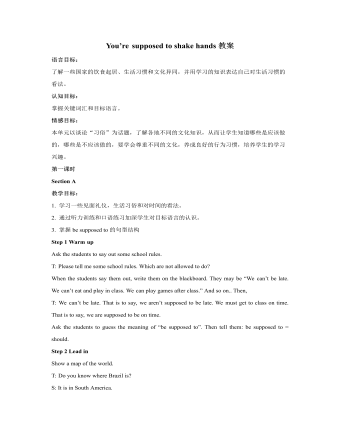
人教版新目标初中英语九年级下册You’re supposed to shake hands教案
教学目标:1. 掌握本单元一些重点词汇的写法和用法。2. 学会自如谈论餐桌礼仪。Step 1 RevisionAsk some students to retell the customs at the table in France in the passage in 3a.Step 2 Self checkPart 1. Fill in each bland with the correct word given. Students do the exercises by themselves at first. Then check the answers. Ask the students to comprehend the sentences and help them point out uses of some words, like “arrive (at / in) sw., spend time / money on sth , spend time / money (in) doing sth.”Part 2. Read about Fan Ling’s experience in a western restaurant. Understand the passage. Point out some key points in the passage.1. be / get used to doing sth. 习惯做某事2. begin with = start with 以….开头3. crowd v. 挤满,塞满 the crowd 人群 crowded adj. 拥挤的Then students discuss about how she would solve her problem. Ask some to share their stories with others.Part 3. Complete the crossword by looking at the sentences on the left. Then check the answers.
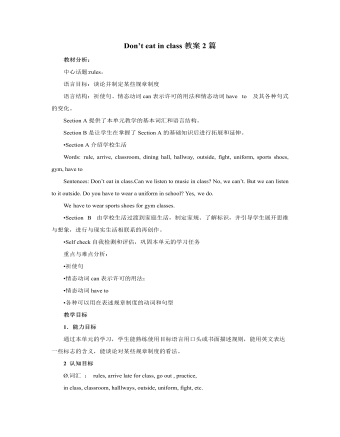
人教版新目标初中英语七年级下册Don’t eat in class教案2篇
Don’t fight. =You can’t fight. (板书,教读)教师把这些句子板书在黑板上,并请学生大声整齐地读祈使句和“can’t”句型,并让学生注意两种句型表达形式的不同和转换,“Don’t …=You can’t…”;并对学生说:These are our school rules. (板书,教读) You can’t break the school rules. Don’t break the school rules.(板书,教读)步骤3 :Practicea. T: Now, each of the students is breaking one of these rules.Please finish 1a.学生看图,完成1a的内容,检查答案并大声朗读校规。b. 听录音,完成1b,选出四位学生都违反了哪条校规;听之前,学生要读会英文名。c. 请两位学生朗读1c部分的句型;要求学生两人一组对话表演,SA扮演外校转来新生,SB告知本校校规。(学生可经过讨论,多说出他们想到的校规,不必只限于书上;教师应给予帮助)2) 第二课时(2a~4)步骤1 :warming up of revisionT: What are the rules at your school?学生使用“can”或祈使句表达各条校规;其中老师可引出“eat in the cafeteria outside”的表达。步骤2 :Practicea.T: Christina is an exchange student. She doesn’t know the rules. Let’s listen, what activities they’re talking about?学生听第一遍时,完成2a;第二遍时,完成2b;b. 请学生领读2c部分,看着2a完成的表格,理解2c活动的要求;分成小组针对2a进行问答;
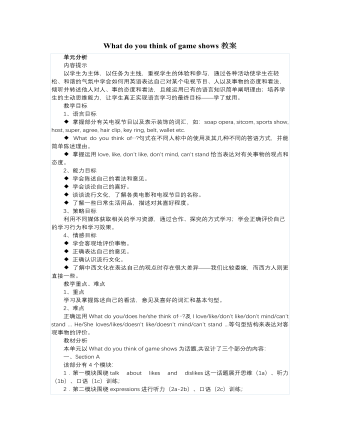
人教版新目标初中英语七年级下册What do you think of game shows教案
五、教学Section B-2c1. Pair work: What do you think of the belt/sunglasses/…? What does your father/mother/… think of your scarf/belt…?2. Group work(1). Teacher shows some different kinds of school uniforms (制服)and asks : “ What do you think of your school uniforms? If you have a chance to choose your school uniforms, what kind would you like to choose?”(2). Discuss in groups.(3).Get some Ss to report in class.说明:这一步旨在让学生运用已有的语言知识谈论对事物的看法和意见,并简单阐明理由,培养学生的主动思维能力和运用英语的能力。六、教学拓展调查电视节目的收视率任务:调查你周围的人对现在各种电视节目的反响。活动过程:1.教师布置任务,让学生调查周围的人(包括他的亲戚朋友和邻居)喜欢收看哪方面的电视节目。2.学生进行调查活动,运用本单元所学的句型What do you think of….? (Why?)What's your favorite game shows?What do you think of talk show?I doesn’t mind it.I like it.I love it.I can’t stand it.3.记录下排在前10位的TV Program,填写调查表,比较其收视率。
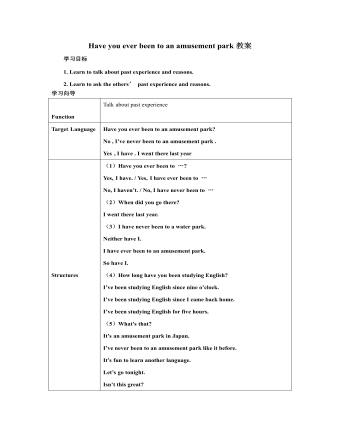
人教版新目标初中英语八年级下册Have you ever been to an amusement park教案
(1)Have you ever been to …? Yes, I have. / Yes, I have ever been to …No, I haven’t. / No, I have never been to …(2)When did you go there? I went there last year. (3)I have never been to a water park. Neither have I. I have ever been to an amusement park. So have I. (4)How long have you been studying English? I’ve been studying English since nine o’clock. I’ve been studying English since I came back home. I’ve been studying English for five hours. (5)What’s that? It’s an amusement park in Japan. I’ve never been to an amusement park like it before. It’s fun to learn another language. Let’s go tonight. Isn’t this great?space museum, amusement park, water park, South America, Peru, Holland, European culture, tour guide, flight attendant, musical instrument, more than, be from, get to, take lessons, neither, discover, graduate, change
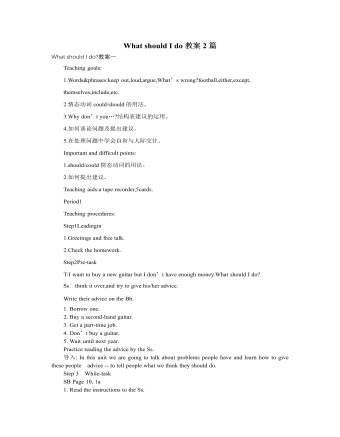
人教版新目标初中英语八年级下册What should I do教案2篇
说明:在帮Li Lei提建议的同时,教育学生如何学好英语。第三课时教学目标1. 语言目标:a) 词汇: Original, in style, haircut, the same as.b) 语言结构:My friend wears the same clothes and has the same haircut as I do.2. 能力目标:大多数学生能够谈论自己喜欢哪种服装,提高查找信息的能力。3. 情感目标:学会如何与朋友相处,要有自己对时尚的看法。教学重点掌握一些重要词汇。教学难点学会谈论问题,并能提出书面建议。◆教学突破首先针对Erin的问题,提出个人的建议,模仿2c部分的对话展开双人交际Pair-work;听老师诵读3a部分的信件,并找出LEFT OUT的问题所在;学生完成3b部分的内容,给Left Out提出书面的建议;学以口头形式提出自己目前存在的某个问题,讲给大家听,让同学们给自己提出一个建议,并作笔录;学生两、三个人分成一组,随意性地进行口语交际,谈论P14的第4部分的某个问题,相互交换意见。
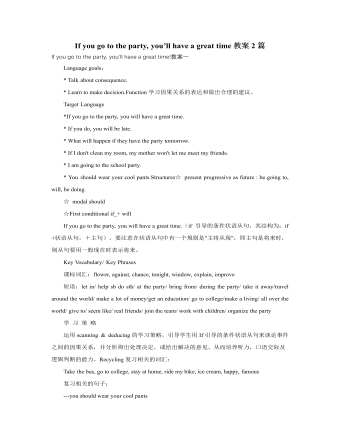
人教版新目标初中英语八年级下册If you go to the party, you’ll have a great time教案2篇
区分宾语从句、定于从句和状语从句宾语从句和状语从句,都叫做主从复合句。宾语从句主要是中考必考的,是初中阶段必掌握的从句,宾语从句主要是掌握三要素,所谓宾语从句,就是宾语在主从复合句当中充当宾语的一个句子,叫做宾语从句。主句的谓语动词是及物动词,后面如果是词或者是短语的话,是简单句,如果是句子的话,肯定是宾语从句。I know that he good at English.就是宾语从句,三要素,一要素是要注意连词,连词一共学了三类连词,一类连词是that口语当中可以省略,就像刚才说的那一句,I hear he is good at English.还有疑问代词、疑问副词,how where when,疑问代词、疑问副词。还有一类连词weather是否的意思,不是状语从句当中的如果,这一定要和如果区分开,这是是否。I don't know if he interested at English。宾语从句要注意if是连词。第二要素是语序,要用陈述举语序。比如说你家有几口人,我们都说How many people are there in you family?但是这是简单句,一旦说成宾语从句,你可以告诉我你家有几口人吗?Could you tell me how many people there are in you family ?
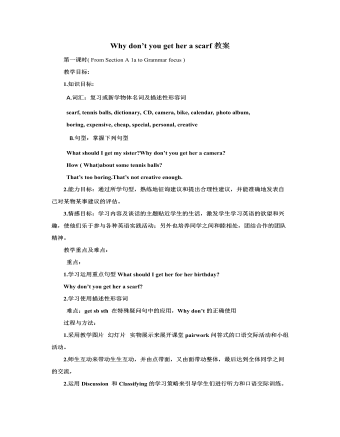
人教版新目标初中英语八年级下册Why don’t you get her a scarf教案
教师带领学生复习有关描述宠物的词汇,采用教师提问学生回答的方进行。如:T:What animals do you think would be good pets?What animals do you think would be bad pets?What do you think are good animals for a six-year-old child?然后学生进行 pairwork 练习。Task two: 师生互动,学习探究 1、播放3a部分的录音,引导学生一边听录音,一边跟读。2、通过听录音学生回答以下问题:Why do you think pot-bellied pigs are popular?What are the advantages and disadvantages of keeping such a pet?教师对学生的回答进行及时点评。3.学习范文,学习重点短语,为下步的模仿写作提供语言素材。T :1. )Have you ever kept a pig as a pet?Do you like pigs? St.:No.…Why don’t you like to keep a pig? St: No.They’re too dirty and lazy(Do you know in some foreign countries like Hollyland, Australia,pigs are the most popular pet.there’s a kind of pig.(图)it has an interesting name? it ‘s called a pot-bellied pig.) Now,let’s learn an article about this kind of interesting pet.2.)play the tapeSt.:Listen and repeat3.)show some Qs on computer(本子St.: read silently,then answerthe Qs(本子)4.)Ask ss. Close book and retell this passage.(what is a pot-bellied pig? Is it a good or bad pet? ) St.: retell it to each other“A pot –bellied pig is a popular pet now…”5.read the article together.St.:.practice reading
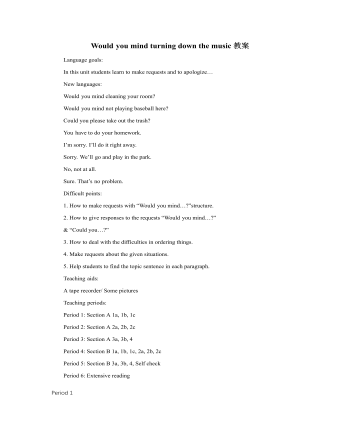
人教版新目标初中英语八年级下册Would you mind turning down the music教案
Step 4. Group work (4)1. Ask a pair of students to read the dialogue. Say, This activity provides speaking, listening and writing practice using the target language.2. Ask students to complete the work in groups.3. Check the answers with the whole class. 4. Explain some of the language points. Step 5. Word review (Self check 1)1. Ask students to read the words and the phrases given. 2. Fill in the blanks with proper forms of these words to complete the sentences. 3. Check the answers with the whole class. Homework:Do activity 2 on page 57 after class. Period 6Teaching aims: 1. Teach vocabulary words and the useful expressions. 2. Enable the students to learn etiquette in different culture. 3. Help the students learn how to behave politely in public places and in daily life. Teaching procedures:Step 1. RevisionHelp students to review the function of making requests through a free talk. Then lead them to the topic of etiquette. Explain the meaning of etiquette. Or, ask students to look it up in the dictionary. Step 2. Pre-reading (Section 1)1. Ask students to read the picture and make a list with their partner about how many rules of etiquette can be seen being broken.
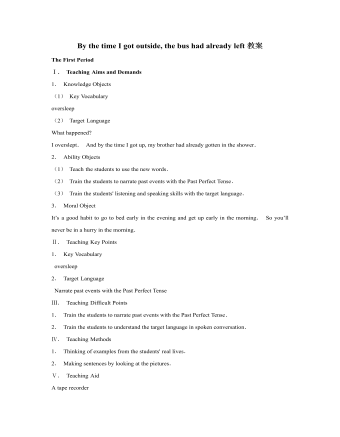
人教版新目标初中英语九年级下册By the time I got outside, the bus had already left教案
Ⅰ. Teaching Aims and Demands1. Knowledge Objects(1) Key Vocabularyoversleep(2) Target LanguageWhat happened?I overslept. And by the time I got up, my brother had already gotten in the shower.2. Ability Objects(1) Teach the students to use the new words.(2) Train the students to narrate past events with the Past Perfect Tense.(3) Train the students' listening and speaking skills with the target language.3. Moral ObjectIt’s a good habit to go to bed early in the evening and get up early in the morning. So you’ll never be in a hurry in the morning.Ⅱ. Teaching Key Points1. Key Vocabularyoversleep2. Target LanguageNarrate past events with the Past Perfect TenseⅢ. Teaching Difficult Points1. Train the students to narrate past events with the Past Perfect Tense.2. Train the students to understand the target language in spoken conversation.Ⅳ. Teaching Methods1. Thinking of examples from the students' real lives.2. Making sentences by looking at the pictures.Ⅴ. Teaching AidA tape recorderⅥ. Teaching ProceduresStep I Revision1. Revise the language points in Unit 8.Ask some questions like this: What volunteer work would you like to do?Help the students to answer, I’d like to…/I love to…/I hope to2. Practice the dialogue in Activity 3c on page 62 again. Get students to role play the similar dialogues with the following.
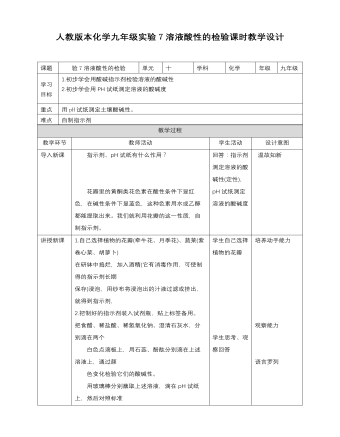
初中化学人教版九年级下册《实验活动7溶液酸碱性的检验》教案
1.自己选择植物的花瓣(牵牛花、月季花)、蔬菜(紫卷心菜、胡萝卜) 在研钵中捣烂,加入酒精(它有消毒作用,可使制得的指示剂长期 保存)浸泡,用纱布将浸泡出的汁液过滤或挤出,就得到指示剂, 2.把制好的指示剂装入试剂瓶,贴上标签备用。 把食醋、稀盐酸、稀氢氧化钠、澄清石灰水,分别滴在两个 白色点滴板上,用石蕊、酚酞分别滴在上述溶液上,通过颜 色变化检验它们的酸碱性。 用玻璃棒分别蘸取上述溶液,滴在pH试纸上,然后对照标准 比色卡比较,得出pH值,也就是酸碱度。 把上述溶液滴在白色点滴板上,用滴管吸一下你自制的指示剂,滴在滴板的溶液里,观察颜色变化,每用一种指示剂,换一下滴板的溶液。 把所得到颜色变色变化的信息和pH值数据填入教材第70页的表中。 3.取少量土壤样品,将土壤样品与蒸馏水按1∶5的质量比在烧杯中混合, 充分搅拌后静置,用玻璃棒蘸澄清的液体,滴在pH试纸上,然后对照 标准比色卡记录读数。
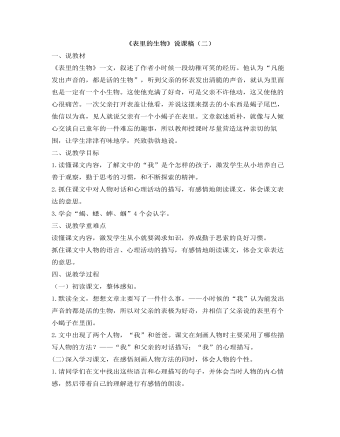
部编人教版六年级下册《表里的生物》说课稿(二)
一、说教材《表里的生物》一文,叙述了作者小时候一段幼稚可笑的经历。他认为“凡能发出声音的,都是活的生物”,听到父亲的怀表发出清脆的声音,就认为里面也是一定有一个小生物。这使他充满了好奇,可是父亲不许他动,这又使他的心很痛苦。一次父亲打开表盖让他看,并说这摆来摆去的小东西是蝎子尾巴,他信以为真,见人就说父亲有一个小蝎子在表里。文章叙述质朴,就像与人倾心交谈自己童年的一件难忘的趣事,所以教师授课时尽量营造这种亲切的氛围,让学生津津有味地学,兴致勃勃地说。二、说教学目标1.读懂课文内容,了解文中的“我”是个怎样的孩子,激发学生从小培养自己善于观察,勤于思考的习惯,和不断探索的精神。2.抓住课文中对人物对话和心理活动的描写,有感情地朗读课文,体会课文表达的意思。
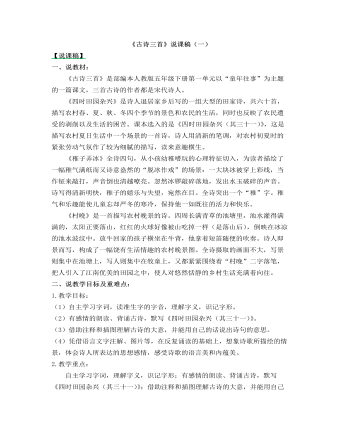
部编人教版五年级下册《古诗三首》说课稿(一)
三、说学情:五年级的学生在古诗学习中已经积累了一定的经验,对文本有独特的阅读体验。课文所描写的情景又都与儿童有关,反映儿童生活,学生也可能有着相似的亲身经历,符合学生的心理,容易引起学生情感的的共鸣,进而在阅读古诗中获得感知,加以模仿,发展想象力,锻炼学生的理解能力和语言表达能力。四、说教法和学法:1.说教法:教学中,设置情景,激发学生认知兴趣,调动学生主动学习的欲望,引导学生主动探究。使学生这一教学主体主动积极地进行语言文字的学习和探究。2.说学法:教学过程体现“以读为本”的新课标理念,教学中,始终让“读”贯穿着整个教学过程。引导学生在读中感受古诗词的优美精湛的语言文字和丰富的人文内涵;在入情入境的读中有所感悟和思考;在读中受到情感的熏陶,获得思想的启迪。
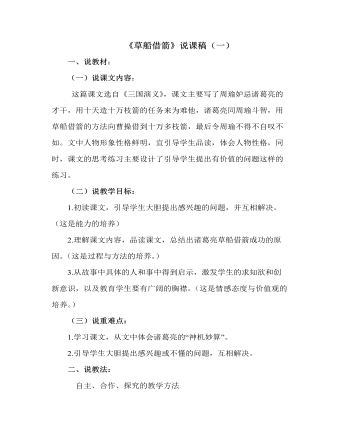
部编人教版五年级下册《草船借箭》说课稿(一)
一、说教材:(一)说课文内容:这篇课文选自《三国演义》,课文主要写了周瑜妒忌诸葛亮的才干,用十天造十万枝箭的任务来为难他,诸葛亮同周瑜斗智,用草船借箭的方法向曹操借到十万多枝箭,最后令周瑜不得不自叹不如。文中人物形象性格鲜明,宜引导学生品读,体会人物性格,同时,课文的思考练习主要设计了引导学生提出有价值的问题这样的练习。(二)说教学目标:1.初读课文,引导学生大胆提出感兴趣的问题,并互相解决。(这是能力的培养)2.理解课文内容,品读课文,总结出诸葛亮草船借箭成功的原因。(这是过程与方法的培养。)3.从故事中具体的人和事中得到启示,激发学生的求知欲和创新意识,以及教育学生要有广阔的胸襟。(这是情感态度与价值观的培养。)
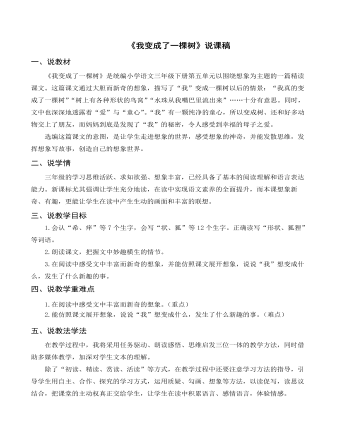
(说课稿)部编人教版三年级下册《我变成了一棵树》
一、说教材《我变成了一棵树》是统编小学语文三年级下册第五单元以围绕想象为主题的一篇精读课文。这篇课文通过大胆而新奇的想象,描写了“我”变成一棵树以后的情景:“我真的变成了一棵树”“树上有各种形状的鸟窝”“水珠从我嘴巴里流出来”……十分有意思。同时,文中也深深地透露着“爱”与“童心”。“我”有一颗纯净的童心,所以变成树、还和好多动物交上了朋友,而妈妈到底是发现了“我”的秘密,令人感受到幸福的母子之爱。 选编这篇课文的意图,是让学生走进想象的世界,感受想象的神奇,并能发散思维,发挥想象写故事,创造自己的想象世界。二、说学情三年级的学习思维活跃、求知欲强、想象丰富,已经具备了基本的阅读理解和语言表达能力。新课标尤其强调让学生充分地读,在读中实现语文素养的全面提升,而本课想象新奇、有趣,更能让学生在读中产生生动的画面和丰富的联想。
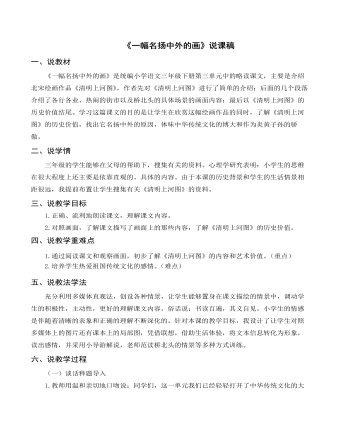
(说课稿)部编人教版三年级下册《一幅名扬中外的画》
一、说教材《一幅名扬中外的画》是统编小学语文三年级下册第三单元中的略读课文,主要是介绍北宋绘画作品《清明上河图》,作者先对《清明上河图》进行了简单的介绍;后面的几个段落介绍了各行各业、热闹的街市以及桥北头的具体场景的画面内容;最后以《清明上河图》的历史价值结尾。学习这篇课文的目的是让学生在欣赏这幅绘画作品的同时,了解《清明上河图》的历史价值,找出它名扬中外的原因,体味中华传统文化的博大和作为炎黄子孙的骄傲。二、说学情三年级的学生能够在父母的帮助下,搜集有关的资料。心理学研究表明:小学生的思维在很大程度上还主要是依靠直观的、具体的内容。由于本课的历史背景和学生的生活情景相距很远,我提前布置让学生搜集有关《清明上河图》的资料。三、说教学目标1.正确、流利地朗读课文,理解课文内容。2.对照画面,了解课文描写了画面上的那些内容,了解《清明上河图》的历史价值。四、说教学重难点1.通过阅读课文和观察画面,初步了解《清明上河图》的内容和艺术价值。(重点)2.培养学生热爱祖国传统文化的感情。(难点)
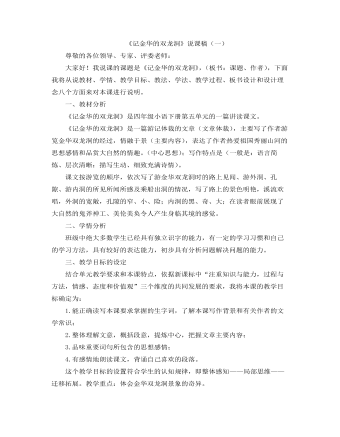
部编人教版四年级下册《记金华的双龙洞》说课稿(一)
一、教材分析《记金华的双龙洞》是四年级小语下册第五单元的一篇讲读课文。《记金华的双龙洞》是一篇游记体裁的文章(文章体裁),主要写了作者游览金华双龙洞的经过,情融于景(主要内容),表达了作者热爱祖国秀丽山河的思想感情和品赏大自然的情趣。(中心思想);写作特点是(一般是:语言简炼、层次清晰;描写生动、细致充满诗情)。课文按游览的顺序,依次写了游金华双龙洞时的路上见闻、游外洞、孔隙、游内洞的所见所闻所感及乘船出洞的情况,写了路上的景色明艳,溪流欢唱,外洞的宽敞,孔隙的窄、小、险;内洞的黑、奇、大;在读者眼前展现了大自然的鬼斧神工、美伦美奂令人产生身临其境的感觉。二、学情分析班级中绝大多数学生已经具有独立识字的能力,有一定的学习习惯和自己的学习方法,具有较好的表达能力,初步具有分析问题解决问题的能力。
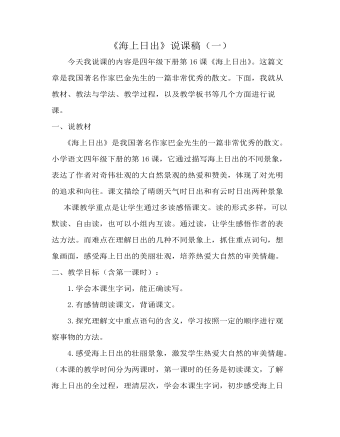
部编人教版四年级下册《海上日出》说课稿(一)
一、说教材《海上日出》是我国著名作家巴金先生的一篇非常优秀的散文。小学语文四年级下册的第16课,它通过描写海上日出的不同景象,表达了作者对奇伟壮观的大自然景观的热爱和赞美,体现了对光明的追求和向往。课文描绘了晴朗天气时日出和有云时日出两种景象本课教学重点是让学生通过多读感悟课文。读的形式多样,可以默读、自由读,也可以小组内互读。通过读,让学生感悟作者的表达方法。而难点在理解日出的几种不同景象上,抓住重点词句,想象画面,感受海上日出的美丽壮观,培养热爱大自然的审美情趣。二、教学目标(含第一课时):1.学会本课生字词,能正确读写。2.有感情朗读课文,背诵课文。3.探究理解文中重点语句的含义,学习按照一定的顺序进行观察事物的方法。
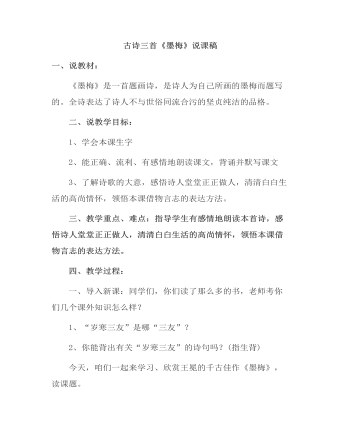
部编人教版四年级下册古诗词三首《墨梅》说课稿(一)
一、说教材:《墨梅》是一首题画诗,是诗人为自己所画的墨梅而题写的。全诗表达了诗人不与世俗同流合污的坚贞纯洁的品格。 二、说教学目标:1、学会本课生字2、能正确、流利、有感情地朗读课文,背诵并默写课文3、了解诗歌的大意,感悟诗人堂堂正正做人,清清白白生活的高尚情怀,领悟本课借物言志的表达方法。三、教学重点、难点:指导学生有感情地朗读本首诗,感悟诗人堂堂正正做人,清清白白生活的高尚情怀,领悟本课借物言志的表达方法。四、教学过程:一、导入新课:同学们,你们读了那么多的书,老师考你们几个课外知识怎么样?1、“岁寒三友”是哪“三友”?2、你能背出有关“岁寒三友”的诗句吗?(指生背)今天,咱们一起来学习、欣赏王冕的千古佳作《墨梅》,读课题。





















